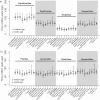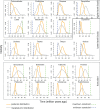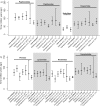Priors and Posteriors in Bayesian Timing of Divergence Analyses: The Age of Butterflies Revisited
- PMID: 30690622
- PMCID: PMC6893297
- DOI: 10.1093/sysbio/syz002
Priors and Posteriors in Bayesian Timing of Divergence Analyses: The Age of Butterflies Revisited
Abstract
The need for robust estimates of times of divergence is essential for downstream analyses, yet assessing this robustness is still rare. We generated a time-calibrated genus-level phylogeny of butterflies (Papilionoidea), including 994 taxa, up to 10 gene fragments and an unprecedented set of 12 fossils and 10 host-plant node calibration points. We compared marginal priors and posterior distributions to assess the relative importance of the former on the latter. This approach revealed a strong influence of the set of priors on the root age but for most calibrated nodes posterior distributions shifted from the marginal prior, indicating significant information in the molecular data set. Using a very conservative approach we estimated an origin of butterflies at 107.6 Ma, approximately equivalent to the latest Early Cretaceous, with a credibility interval ranging from 89.5 Ma (mid Late Cretaceous) to 129.5 Ma (mid Early Cretaceous). In addition, we tested the effects of changing fossil calibration priors, tree prior, different sets of calibrations and different sampling fractions but our estimate remained robust to these alternative assumptions. With 994 genera, this tree provides a comprehensive source of secondary calibrations for studies on butterflies.
Keywords: Butterflies; Early Cretaceous; Papilionoidea; fossils; host plants; marginal prior; time-calibration.
© The Author(s) 2019. Published by Oxford University Press, on behalf of the Society of Systematic Biologists. All rights reserved. For permissions, please email: journals.permissions@oup.com.
Figures





References
-
- Ackery P.R. 1988. Hostplants and classification: a review of nymphalid butterflies. Biol. J. Linn. Soc. Lond. 33(2):95–203.
-
- Beccaloni G.W., Viloria A.L., Hall S.K., Robinson G.S.. 2008. Catalogue of the hostplants of the Neotropical butterflies. Zaragoza, Spain: Sociedad Entomológica Aragonesa (SEA).
-
- Braby M.F., Vila R., Pierce N.E.. 2006. Molecular phylogeny and systematics of the Pieridae (Lepidoptera: Papilionoidea): higher classification and biogeography. Zool. J. Linn. Soc. 147:239–275.
-
- Brenner G.J. 1996. Evidence for the earliest stage of angiosperm pollen evolution: a paleoequatorial section from Israel In: Taylor D.W., Hickey L.J., editors. Flowering plant origin, evolution & phylogeny. Boston, MA: Springer; p. 91–115.

